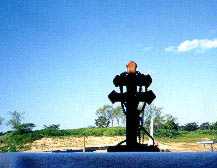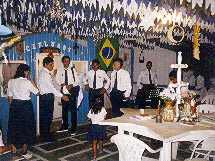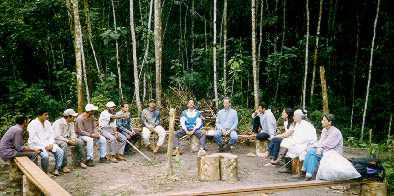|
|



  
Juruá
New churches in the forest
Cruzeiro do Sul / Rodrigues Alves
Ipixúna / Seringal Adélia - Céu do
Juruá
 
The Juruá Valley was inhabited in the past by 49 indigenous tribes, all of them from
the the Arawak or Aruak family. Today, only few groups exist, among them the Ararauas, the
Katuquinas, the Kulinas, the Kaxinauás, the Kampas and the Poianauas. In Cruzeiro do Sul
lives the tribe of Nauás, extinguished. The municipal district has approximately 60.000
thousand inhabitants and the city is the largest in the whole area of the Juruá river.
 The syringe, that was in the past the
great source of local income, is in complete decadence. The great economical activity is
the manioc flour, famous in all the western Amazonia. The city has high living cost: the
highway that links to the Capital only works two months a year and most of the goods for
consumption comes by airplane. The river only allows the navigation of big boats during
small seasons. The syringe, that was in the past the
great source of local income, is in complete decadence. The great economical activity is
the manioc flour, famous in all the western Amazonia. The city has high living cost: the
highway that links to the Capital only works two months a year and most of the goods for
consumption comes by airplane. The river only allows the navigation of big boats during
small seasons.
 High Juruá is inserted in the great area of the
East of the rivers of the amazon basin, known as the place of higher biodiversity on
earth. It is enormous the variety of the fauna and flora. The Juruá river is born in
Peru, it has 3.000 kilometers of extension and it is among the 10 larger rivers of the
planet. High Juruá is inserted in the great area of the
East of the rivers of the amazon basin, known as the place of higher biodiversity on
earth. It is enormous the variety of the fauna and flora. The Juruá river is born in
Peru, it has 3.000 kilometers of extension and it is among the 10 larger rivers of the
planet.



Cruzeiro
do Sul
Santo Daime's doctrine arrived to the city of
Cruzeiro do Sul in the beginning of the 90's, when the Eclectic Church of the Universal
Flowing Light was founded by Antonio Gomes da Silva, CEFLUAGS, under Carlos Augusto Assem
de Carvalho presidency. The Church works today with about 60 fardados and an expressive
number of visitors. The head group of the Center is responsible for Santo Daime's
preparation for distribution in the whole area.
 Rodrigues
Alves,
Rodrigues
Alves,
A small municipal district linked to Cruzeiro do
Sul (l hour through land or river), it gathers a group of approximately 30 fardados. It is
still a group in formation, driven by Antônio Francisco dos Santos, and leaning for the
Church of Cruzeiro do Sul. The prominence of the group is the knowledge of the material
used in Santo Daime's Workmanship, the liana Jagube and the leaf Queen, identified for
them in the Forest.


Ipixuna,
One day by boat from ship of Cruzeiro do Sul, we
find the city which gathers great part of Padrinho Sebastião's family. There, Alfredo
found many cousins, sons and daughters of Raimundo Mota Melo, his father's brother. The
organized together the beginning of a spiritual and material work in the city of Ipixuna
and in Seringal Adélia. Far in the middle of the Forest, Ipixuna have only 12.000
inhabitants and is linked to the world only by water. There exists a small airport, where
it is possible to arrange a monomotor in case of urgencies.
It was bought a land of 4 thousand meters in the rear part of the
city, close to the Forest, where it was built the Church and a small lodge. The
responsible for the Center is one of the cousins, Façanha Mota Melo.


The
Estorrões - Céu do Juruá,
Part of Seringal Adélia, where in the
past was developed all the agriculture and syringe production, was the chosen place by
Padrinho Alfredo to implant the Céu do Juruá Ecological Village. Solid earth, where the
inundations can't reach during the time of the river floods, the area was reopened more
than one year after the first visit made to Juruá. Part of Seringal was bought from
Padrinho Sebastião's old boss, still alive and today member of the Cruzeiro do Sul
Church. There are about 3 thousand hectares, with 3 great lakes and countless igarapés.
The Church of the Comunidade Céu of Juruá, as it was conceived by
the Padrinho Alfredo, it is not built yet. The spiritual works were initiate in a small
yard beside the first opening done in Estorrões, where it was built a house, a general
kitchen and a shelter camp to workers and visitors. There are already two great large
tents – in Rio Juruá's margin and on solid earth, three hours by walk from the edge
of the river in the station of the drought – this place is also used as Church,
bedroom and storage of goods. Necil Mota Melo is the one in charge for the spiritual and
material works in Padrinho Alfredo's absence. About 10 families were settled in Seringal
Adélia starting from l999. |
|
|